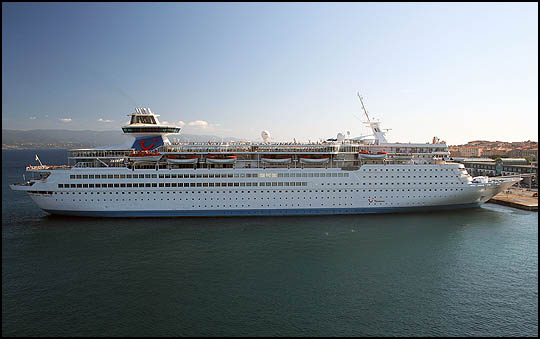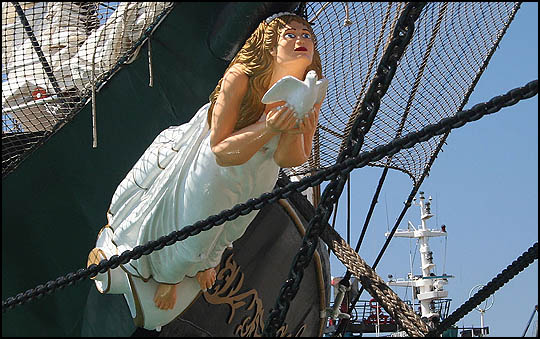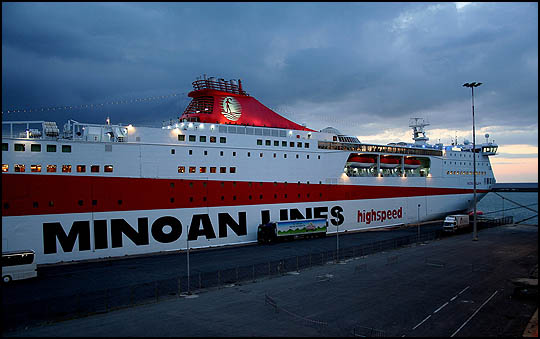A couple of weeks ago I was celebrating the end of a long-running task - the scanning of some 700 postcards from the Hayley Easthope collection. Readers may well have been wondering when to expect to see them, but with so many postcards from so many different countries it was a daunting job trying to think of how to present them!
So here's the first instalment. Wales is the country most represented outside England so today's selection are all of Wales. There are around 80 postcards from Wales so to try to arrange them into suitably sized collections, today's postcards are all older monochrome shots. They were mostly published as black and white, but there are a couple of sepia treated examples.

Llangwyfan Old Church, (The Church In The Sea) Aberffraw, nr. Rhosneigr. This tiny 13th century church of St Cwyfan stands on the south west coast of Anglesey. The land on which it stands was once part of the island of Anglesey itself, but erosion of the land by the sea sometime after 1770 caused the land around the church to be cut off at high tide, forming an island known as Cribinau. By the early 1900s the erosion was encroaching on the churchyard and some graves were lost to the sea, at which point a wall was built around the remains of the island to protect it.
In the latter half of the 18th century a very strange thing occurred. In 1766 Dr Thomas Bowles, an ageing English priest, was appointed to St Cwyfan's church. The congregation numbered 500 and of those, 99% spoke Welsh but no English. Dr Bowles spoke English but no Welsh... Not surprisingly the locals demanded he be replaced. A court in 1773 found that he should not have been appointed to a Welsh-speaking parish, but now that he had been - and legally - he could not be removed. In the event, he stayed for another ten months before he passed away, leaving the way open for his replacement by a Welsh-speaking priest.

Wrexham, The Yale Tomb & Sundial. Specifically this is the tomb of the exotically named Elihu Yale, born in 1649 in Boston, Massachusetts. He worked for the British East India Company and whilst in their employ became Governor of Fort St George in Madras. He made himself extremely rich mostly by flaunting the rules of the company and entering into secret deals. After five years he was removed by the East India Company and returned to live at Plas Grono, the family mansion near Wrexham in Wales, where he proceeded to enjoy spending his accumulated wealth. Part of it was spent in response to a request for help from the Collegiate School of Connecticut. Yale sent them some books, a portrait of King George I and some goods which were sold for the very considerable sum (at the time) of £800. A new building was erected and called Yale in gratitude and later Yale became the name of the entire institution.

The seaside resort of Tenby is one of Britain's most westerly towns, but still manages to have a seafront facing east on the south coast of Wales. This gives it a sheltered harbour and it was an early trading post between Wales and the Norsemen in the 9th century. There are remains of 13th century town walls. Castle Hill, seen in the top left segment of the postcard, started off as a hill fort and the stone castle was built following the Norman Conquest by the Earls of Pembroke. Meg and Ern sent this postcard to an address in Wellington, Shropshire in July 1959. They had attended a wedding on the previous Saturday and had then journeyed by train to reach Tenby that night. Perhaps they were the two who got married? The message finishes with a somewhat breathless "See you sometime - don't know when!"

The Promenade, Colwyn Bay, North Wales. Colwyn Bay is a resort roughly halfway along the north coast of Wales in the county of Denbighshire, facing onto the Irish Sea. It enjoys a mild climate thanks to the wind passing over the mountains of Snowdonia to the south which then dry out and get warmer as they descend towards Colwyn Bay. A lovely row of old-style motor cars along the Promenade with a half-cab single deck bus approaching in the distance. The card was sent back to Wellington, Shropshire on 11 July 1956 during which week "A heat wave decided to come too!"
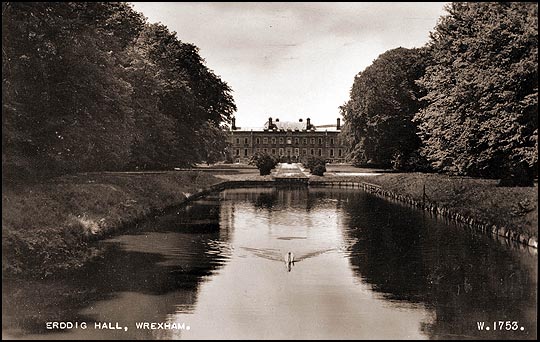
Erddig Hall, Wrexham. Erddig Hall is a National Trust stately home (voted the UK's "favourite historic house" by Britain's Best). It was built by the High Sheriff of Denbighshire, Joshua Edisbury, in 1684-87. It was sold to John Mellor, Master of Chancery, in 1714 and on his death in 1733 passed to the Yorke family who owned it through several generations through 240 years until it was given to the National Trust in 1973.
Several years earlier a shaft from Bersham Colliery had collapsed underneath the house, causing a subsidence of five feet, requiring a substantial sum of money to save the house. Compensation paid for the necessary structural underpinning, but 63 acres of parkland had to be sold to finance the restoration of the house.
Writing on 21 July 1954, in a hand that turns each of the capital letters F, S and T to a J, the cursive lower-case is thankfully easier to read. "Just to let you know we are having a nice time and lovely weather. We are getting out somewhere each day. Hope Rex hasn't been fretting. We shall stay until the last train on Friday but don't wait for us if that is too late for you. All are well here and your Dad and I are feeling better for the change. Love to both, Mum."

Wrexham, The Cup and Saucer, Erddig Park. Three years later, Mum makes the return journey but obviously alone, for she writes: "Just to let you know I am having a nice time and a good rest. Could manage a month like this, shall be home Friday. Love to both, Mum."
The Cup and Saucer, situated close to Erddig Hall was a pool or font, filled with water by a hydraulic ram which forced water uphill from the nearby river.
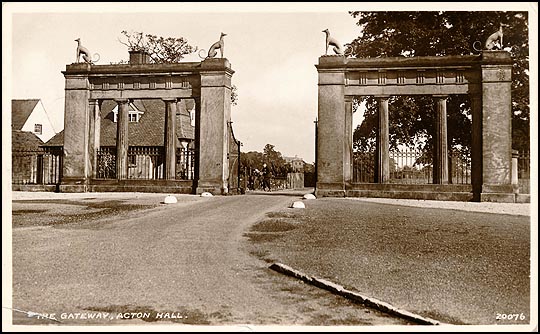
The Gateway, Acton Hall. Another once-stately home near to Wrexham, Acton Hall was demolished in 1954 having become badly dilapidated. It had once been owned by the Jeffreys family - they who included the infamous Judge Jeffreys, the Hanging Judge, in the 17th century.
The card was sent again in 1954 back to the same address as the Erddig Hall postcard, by the same Mum and Dad. The postmark is missing the exact date but presumably this was from a different visit as although there is the same hope that "Rex is ok" (what was the matter with that dog / cat / guinea pig / goldfish / milkman?), on this occasion the absent parents are due to arrive on the "last train on Wednesday." Perhaps this time because the "weather is very wet."

Harbour and Beach, Saundersfoot. Saundersfoot is a hop, skip and jump up the coast from Tenby. The harbour dates only from Parliament granting permission in 1829, though coal from the many mines around the village had been loaded onto boats from the beach for centuries. Another card with a line of cars of the 1950s. This time a more modern light-coloured box saloon can be seen third from the right. This card has also gone back to Wellington, Shropshire but was sent by Meg (due to be half of the couple Meg and Ern who we met earlier) on 12 June 1957. She writes: "Having a lovely time here at Tenby. Weather perfect, been in for a swim once or twice every day. It has a beautiful stretch of sandy beach."
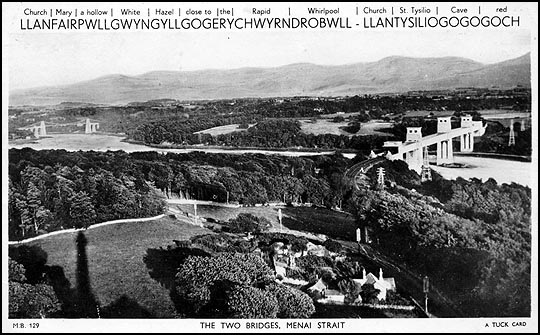
The Two Bridges, Menai Strait. The Menai Strait separates the island of Anglesey from the Welsh mainland. Cross from the Welsh mainland to Anglesey and turn left and you come to the village whose name trips so easily from the tongue: Llanfairpwillgwyngyllgogerychwyrndrobwll-llantysiliogogogoch... As the old joke goes: I asked the guy behind the cafe counter to say the name of the place really slowly. He said "B-u-r-g-e-r K-i-n-g...". This time another branch of the family is roaming Wales and writing back to Shropshire. On the 1st of July 1954 the message went "Thursday. Shall be pleased to see you at the usual time on Sunday. Order a fine sunny day. Love Aunty P, Uncle E."

Horse Shoe Falls, Llangollen. This is a 460-feet (140m) long weir, stocking a pool from which water can be released into the Llangollen Canal. It dates from 1908. This card is unused and therefore cannot be dated.















